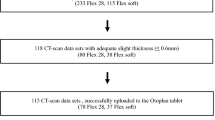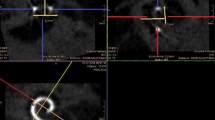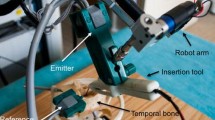Abstract
The aim of this study was to assess the mental representation of the insertion axis of surgeons with different degrees of experience, and reproducibility of the insertion axis in repeated measures. A mastoidectomy and a posterior tympanotomy were prepared in five different artificial temporal bones. A cone-beam CT was performed for each temporal bone and the data were registered on a magnetic navigation system. In these five temporal bones, 16 surgeons (3 experts; >50 cochlear implant surgery/year; 7 fellows with few cochlear implant experience, and 6 residents) were asked to determine the optimal insertion axis according to their mental representation. Compared to a planned ideal axis, the insertion axis was better determined by the experts with higher accuracy (axial: 7° ± 1.5°, coronal: 6° ± 1.5°) than fellows (axial: 14° ± 1.7°, coronal: 13° ± 1.7°; p < 0.05), or residents (axial: 15° ± 1.5°; p < 0.001, coronal: 17° ± 1.9°; p < 0.001). This study suggests that mental representation of the cochlea is experience-dependent. A high variation of the insertion axis to the scala tympani can be observed due to the complexity of the temporal bone anatomy and lack of landmarks to determine scala tympani orientation. Navigation systems can be used to evaluate and improve mental representation of the insertion axis to the scala tympani for cochlear implant surgery.









Similar content being viewed by others
References
Berrettini S, Forli F, Passetti S (2008) Preservation of residual hearing following cochlear implantation: comparison between three surgical techniques. J Laryngol Otol 122:246–252
Helbig S, Van de Heyning P, Kiefer J, Baumann U, Kleine-Punte A, Brockmeier H et al (2011) Combined electric acoustic stimulation with the PULSARCI(100) implant system using the FLEX(EAS) electrode array. Acta Otolaryngol (Stockh) 131:585–595
Venail F, Mathiolon C, Menjot S, Piron JP, Sicard M, Villemus F et al (2015) Effects of electrode array length on frequency-place mismatch and speech perception with cochlear implants. Audiol Neurotol. 20:102–111
Nguyen Y, Mosnier I, Borel S, Ambert-Dahan E, Bouccara D, Bozorg-Grayeli A et al (2013) Evolution of electrode array diameter for hearing preservation in cochlear implantation. Acta Otolaryngol (Stockh) 133:116–122
Adunka OF, Dillon MT, Adunka MC, King ER, Pillsbury HC, Buchman CA (2014) Cochleostomy versus round window insertions: influence on functional outcomes in electric-acoustic stimulation of the auditory system. Otol Neurotol 35:613–618
Escude B, James C, Deguine O, Cochard N, Eter E, Fraysse B (2006) The size of the cochlea and predictions of insertion depth angles for cochlear implant electrodes. Audiol Neurotol 11:27–33
Erixon E, Högstorp H, Wadin K, Rask-Andersen H (2009) Variational anatomy of the human cochlea: implications for cochlear implantation. Otol Neurotol 30:14–22
Martinez-Monedero R, Niparko JK, Aygun N (2011) Cochlear coiling pattern and orientation differences in cochlear implant candidates. Otol Neurotol 32:1086–1093
Avci E, Nauwelaers T, Lenarz T, Hamacher V, Kral A (2014) Variations in microanatomy of the human cochlea. J Comp Neurol 522:3245–3261
Meshik X, Holden TA, Chole RA, Hullar TE (2010) Optimal cochlear implant insertion vectors. Otol Neurotol 31:58–63
Breinbauer HA, Praetorius M (2015) Variability of an ideal insertion vector for cochlear implantation. Otol Neurotol 36:610–617
Roosli C, Sim JH, Möckel H, Mokosch M, Probst R (2013) An artificial temporal bone as a training tool for cochlear implantation. Otol Neurotol 34:1048–1051
Bakhos D, Velut S, Robier A, Alzahrani M, Lescanne E (2010) Three-dimensional modeling of the temporal bone for surgical training. Otol Neurotol 31:328–334
Verbist BM, Skinner MW, Cohen LT, Leake PA, James C, Boëx C et al (2010) Consensus panel on a cochlear coordinate system applicable in histologic, physiologic, and radiologic studies of the human cochlea. Otol Neurotol 31:722–730
Nguyen Y, Miroir M, Vellin J-F, Mazalaigue S, Bensimon J-L, Bernardeschi D et al (2011) Minimally invasive computer-assisted approach for cochlear implantation: a human temporal bone study. Surg Innov 18:259–267
Bozorg A, Esquia-Medina G, Nguyen Y, Mazalaigue S, Vellin J-F, Lombard B et al (2009) Use of anatomic or invasive markers in association with skin surface registration in image-guided surgery of the temporal bone. Acta Otolaryngol (Stockh) 129:405–410
Bernardeschi D, Nguyen Y, Villepelet A, Ferrary E, Mazalaigue S, Kalamarides M et al (2013) Use of bone anchoring device in electromagnetic computer-assisted navigation in lateral skull base surgery. Acta Otolaryngol (Stockh) 133:1047–1052
Li PMMC, Wang H, Northrop C, Merchant SN, Nadol JB (2007) Anatomy of the round window and hook region of the cochlea with implications for cochlear implantation and other endocochlear surgical procedures. Otol Neurotol 28:641–648
Franz BK, Clark GM, Bloom DM (1987) Surgical anatomy of the round window with special reference to cochlear implantation. J Laryngol Otol 101:97–102
Basura GJ, Adunka OF, Buchman CA (2010) Scala tympani cochleostomy for cochlear implantation. Oper Tech Otolaryngol-Head Neck Surg 21:218–222
Briggs RJS, Tykocinski M, Xu J, Risi F, Svehla M, Cowan R et al (2006) Comparison of round window and cochleostomy approaches with a prototype hearing preservation electrode. Audiol Neurotol 11:42–48
Havenith S, Lammers MJW, Tange RA, Trabalzini F, della Volpe A, van der Heijden GJMG et al (2013) Hearing preservation surgery: cochleostomy or round window approach? A systematic review. Otol Neurotol 34:667–674
Adunka O, Kiefer J, Unkelbach MH, Radeloff A, Gstoettner W (2005) Evaluating cochlear implant trauma to the scala vestibuli. Clin Otolaryngol 30:121–127
Iseli C, Adunka OF, Buchman CA (2014) Scala tympani cochleostomy survey: a follow-up study. Laryngoscope 124:1928–1931
Vision Marr D (2010) A computational investigation into the human representation and processing of visual information. MIT Press, Cambridge
Sternberg RJ, Mio JS (2009) Cognitive psychology. Cengage Learning/Wadsworth, Australia
DesCôteaux JG, Leclère H (1995) Learning surgical technical skills. Can J Surg 38:33–38
Wang RF, Spelke ES (2003) Comparative approaches to human navigation. In: Jeffery KJ (ed) The neurobiology of spatial behaviour, 1st edn. Oxford University Press, Oxford, pp 119–143
Broadbent HJ, Farran EK, Tolmie A (2014) Egocentric and allocentric navigation strategies in Williams syndrome and typical development. Dev Sci 17:920–934
Avraamides MN, Loomis JM, Klatzky RL, Golledge RG (2004) Functional equivalence of spatial representations derived from vision and language: evidence from allocentric judgments. J Exp Psychol Learn Mem Cogn 30:804–814
Ang SY, Lee K (2008) Central executive involvement in children’s spatial memory. Memory 16:918–933
Trier P, Noe K, Sørensen MS, Mosegaard J (2008) The visible ear surgery simulator. Stud Health Technol Inform 132:523–525
Arora A, Khemani S, Tolley N, Singh A, Budge J, Varela D et al (2012) Face and content validation of a virtual reality temporal bone simulator. Otolaryngol-Head Neck Surg 146:497–503
O’Leary SJ, Hutchins MA, Stevenson DR, Gunn C, Krumpholz A, Kennedy G et al (2008) Validation of a networked virtual reality simulation of temporal bone surgery. Laryngoscope 118:1040–1046
Miroir M, Nguyen Y, Kazmitcheff G, Ferrary E, Sterkers O, Bozorg A (2012) Friction force measurement during cochlear implant insertion: application to a force-controlled insertion tool design. Otol Neurotol 33:1092–1100
Nguyen Y, Miroir M, Kazmitcheff G, Sutter J, Bensidhoum M, Ferrary E et al (2012) Cochlear implant insertion forces in microdissected human cochlea to evaluate a prototype array. Audiol Neurotol 17:290–298
Acknowledgments
The authors would like to thank all the surgeons for their participation in this evaluation.
Author information
Authors and Affiliations
Corresponding author
Rights and permissions
About this article
Cite this article
Torres, R., Kazmitcheff, G., Bernardeschi, D. et al. Variability of the mental representation of the cochlear anatomy during cochlear implantation. Eur Arch Otorhinolaryngol 273, 2009–2018 (2016). https://doi.org/10.1007/s00405-015-3763-x
Received:
Accepted:
Published:
Issue Date:
DOI: https://doi.org/10.1007/s00405-015-3763-x




